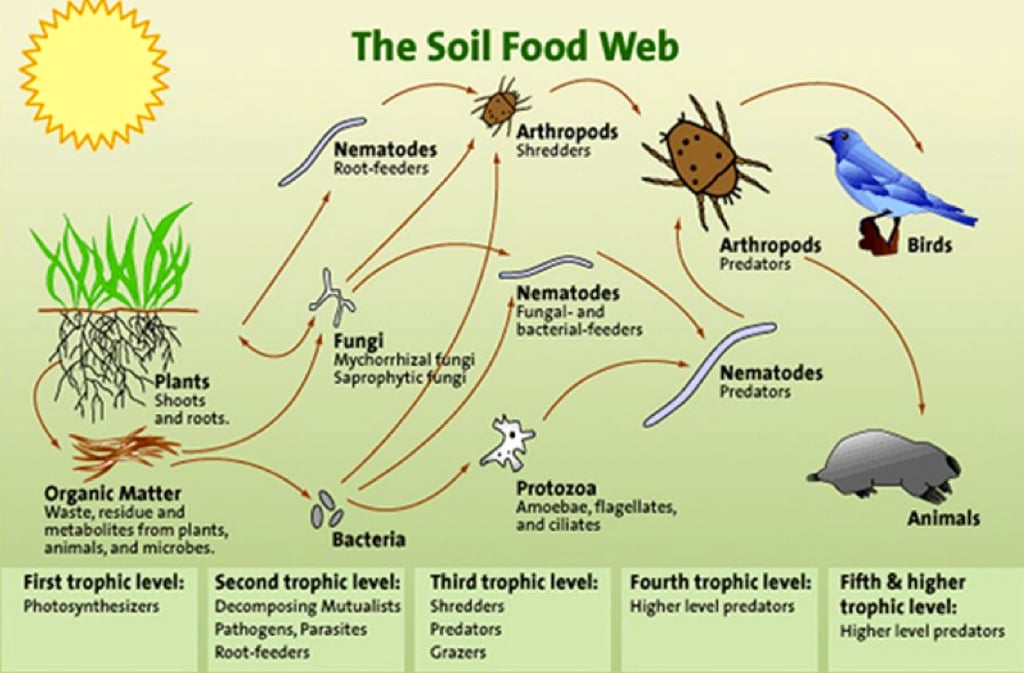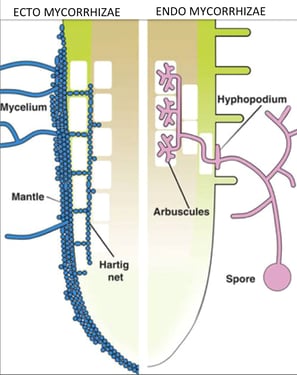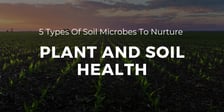By Kaitlyn Ersek on Jul 24, 2015 7:37:40 AM
The soil is truly a living thing, filled with millions and billions of life forms, busily working away according to Mother Nature’s plans. In fact, one teaspoon of agricultural or turf soil contains:
- 100 million to 1 billion bacteria
- Several yards of mycelium (fungi)
- 7,000 protozoa
- 10-20 nematodes
- Up to 100 arthropods
- 5 - 30 earth worms
What happens in the soil when everything is balanced and functioning as Mother Nature intended?
1. All functional soil is a balanced environment, where plants, microbes, protozoa, nematodes and worms contribute to the well-being of each other.
For example, plants exude sugars, amino acids and organic acids through photosynthesis into the soil. Bacteria and fungi then eat the plant exudates. Next, the bacteria and fungi are eaten by each other, as well as by protozoa, nematodes and worms. In the end, all soil organisms die (including plants) and become organic matter. This dead biomass then becomes food for the living organisms in the soil.
 Photo above from USDA Natural Resources Conservation Services. http://www.nrcs.usda.gov/wps/portal/nrcs/detailfull/soils/health/biology/?cid=nrcs142p2_053868
Photo above from USDA Natural Resources Conservation Services. http://www.nrcs.usda.gov/wps/portal/nrcs/detailfull/soils/health/biology/?cid=nrcs142p2_053868
2. In a functional soil, biology contributes to soil structure.
Exudates from plant, microorganisms, and multi-celled organisms serve as a glue assisting in the aggregation of soil particles. While worms, tunnel in the soil, creating air space and to facilitate drainage within the soil.
3. In a functional soil, microorganisms decompose organic matter. In fact, without microorganisms, dead plant and animal life wouldn’t decompose.
Ultimately, soils would become putrid and compaction layers would be created. However, with microorganisms, decomposition occurs naturally. During decomposition, microorganisms provide nutrients (including carbon) to the soil and create humus (the stable form – an end product of organic matter decomposition), contributing to the soil structure.
4. In a functional soil, organisms (including plants) contribute to a mineralization cycle.
Nutrients are immobilized when they are used by plants and soil organisms. When immobilized, minerals are tied up in the chemistry of living organisms. Immobilized nutrients are freed (this is called mineralization) to be used by all living organisms when other organisms die. During decomposition these nutrients are released from multi-cell plants and animals. When single cell organisms die, the cell walls break and chemicals and nutrients are released to the soil.
5. In a functional soil, nitrogen fixing bacteria (Rhizobia) and nitrifying bacteria make nitrogen available to plants.
Nitrogen fixing (rhizobia) live in a symbiotic relationship with roots of legumes (beans, alfalfa, clover). The bacteria receive sugars and other plant chemicals from the plant and in return, Rhizobia convert nitrogen from the soil atmosphere into nitrogen compounds usable by the plant.
Nitrifying bacteria live in the soil (not in direct association with plants). These bacteria change nitrogen in the soil from ammonium to nitrite and then to nitrate (a plant usable form of nitrogen).
6. In a functional soil, certain fungi live in symbiotic (help each other) relationships with plants.
For e xample, mycorrhizae are fungi that live in direct association with plant roots. In this relationship the plants provide sugars, amino acids and other plant acids to the fungi. The fungi then facilitate water and nutrient uptake by the roots.
xample, mycorrhizae are fungi that live in direct association with plant roots. In this relationship the plants provide sugars, amino acids and other plant acids to the fungi. The fungi then facilitate water and nutrient uptake by the roots.
There are two different types of mycorrhizae: Endo and Ecto Mycorrhizae. Endo mycorrhizae penetrate and attach to the root hairs of the plant roots. However, Ecto mycorrhizae lie in close proximity to the plant roots but do not actually penetrate the cell wall of the root hair.
7. In a functional soil, fungi and bacteria serve different decomposition roles.
Fungi have evolved to be expert organisms for decomposition of lignin, which is abundant in tree, leaf and branch litter on the forest floor. This is one of the reasons why fungi dominate in forest soil as opposed to agricultural or turf soil. On the other hand, agricultural and turf plants exude large amounts of sugars and organic chemicals. These are easily digested by bacteria. That, in addition to low lignin content in agricultural and turf litter, is why bacteria dominate this soil.
Want to learn more?
Click the movie below to watch Dr. Bob’s webinar entitled Digging into the soil food web.

![Holganix Greater Green Goal [2024 Update]](https://www.holganix.com/hs-fs/hubfs/Blog%20headers%20%232%20%2875%29.jpg?width=224&height=112&name=Blog%20headers%20%232%20%2875%29.jpg)




![Holganix Greater Green Goal [2024 Update]](https://www.holganix.com/hs-fs/hubfs/Blog%20headers%20%232%20%2875%29.jpg?width=120&height=66&name=Blog%20headers%20%232%20%2875%29.jpg)







